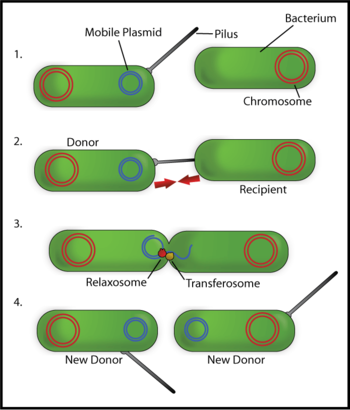Boston University/Conjugation
From 2007.igem.org
Conjugation
As explained in the textbook Medical Microbiology by Samuel Baron, conjugation is a process where donor bacteria transfer some or all of their genome to recipient bacteria via a cytoplasmic “bridge” called the pilus[1].
Figure 1. Schematic drawing of bacterial conjugation. 1- Donor cell produces pilus; 2- Pilus attaches to recipient cell, brings the two cells together; 3- The mobile plasmid is nicked and a single strand of DNA is then transferred to the recipent cell; 4- Both cells recircularize their plasmids, synthesize second strands, and reproduce pili. Both cells are now viable donors.
Because of challenges in other studies that attempted to use electroporation to transform plasmids into S. oneidensis, the iGEM team is preparing to use conjugation as the primary means of incorporating plasmids with mutated transcription factors hlyU, SO4157, or SO1415 into MR-1. Thus, in order to create S. oneidensis strains with these mutated transcription factors, the iGEM team will first mutate the transcription factors through error-prone PCR, ligate the transcription factors into a vector plasmid, transform the vector plasmid into conjugation-capable bacteria, and then finally use conjugation to transform S. oneidensis with the vector plasmid. The genes responsible for the construction of the pilus and accompanying conjugal transfer are collectively labeled tra genes[2]. The iGEM team will be using E. coli strain S17-1 (sold by ATCC), which has these tra genes already incorporated into its bacterial chromosome, as a mobilization host for the plasmid vector[3]. As for the plasmid vector itself, the iGEM team has selected plasmid pJQ200 (also sold by ATCC) for several reasons.
